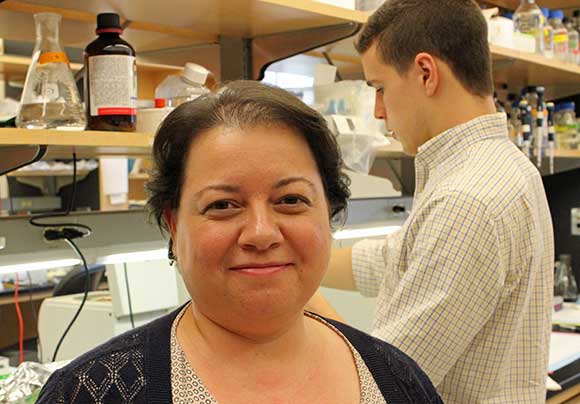
Cell biologist Eda Yildirim in her lab, where researchers are taking aim at little understood genetic mechanisms. Photo by Karl Leif Bates.
Eda Yildirim, a new faculty member in the medical school’s department of cell biology, is among a growing movement of Duke scientists trying to understand how genes are silenced or activated in both health and disease.
DNA still gets the most press, but what Yildirim finds more interesting is the RNA molecules that interact with DNA in myriad ways to control its operations.
Through the carefully calibrated actions of many kinds of RNA, the genome can be dynamic enough to respond quickly to infections or other changes in the body’s environment, yet most of the time it just stays quiet and remains reliable enough to still function after being copied over and over.
As a tool to understand one part of RNA’s regulation of genes, Yildirim’s lab is focused on the process that silences one of the two X chromosomes found in a female mammal. Female offspring get one X from each parent, but if the genes on both chromosomes were active, all sorts of things could go wrong. So the developing embryo turns off one of the Xs in each cell.
Yildirim says a long, noncoding RNA molecule called Xist (X-inactive specific transcript -- pronounced “exist”) is the key to this process.
It’s well-known that Xist is crucial to initiate silencing on one X chromosome, but her lab is trying to figure out how Xist maintains the silence of the inactive X chromosome and how this process is essential during mammalian development.
Yildirim thinks there’s an important link between Xist and cancer because some cancer cells are seen to lack the inactivated clump of X chromosome that Xist creates, which is known as the Barr body in human cells.
“The question was, is Xist loss or change in the amount of active X-chromosome a cause or a consequence of cancer?” Yildirim asks.
Two years ago in a Cell paper, work she did at Jeannie Lee’s laboratory at Harvard showed that functioning Xist is a cancer suppressor in mice, which suggested that losing it could be a cancer precursor. When she deleted Xist from the blood cells of mouse embryos, female pups went on to develop various blood cancers, including leukemia.
As fascinating as this new idea is for cancer, Yildirim really views Xist as a tool to understanding even broader questions. She wants to know how processes governed by these long, noncoding RNAs affect genome function. She is particularly interested in understanding how genes specific to some types of cells are turned on or off and how non-coding RNAs participate in establishing states of gene activity that can be inherited across generations -- a field now known as epigenetics.
Yildirim hopes to learn how misregulations in these systems drive cancer in cells. She’s also studying how nuclear structure affects gene activity and the organization of the genome.
Duke is a great fit for her, she says more than once. “You work so hard to come to this level and finding the right home where you can get inspired, cultivate ideas and grow is the key.” She’s settling in, though her office in the Nanaline Duke building is still notably bare after almost a year. Since her arrival to Duke she was awarded with the prestigious Whitehead Scholar award and a Leukemia Research Foundation grant.
“Putting the right people together is essential to having a productive team that can work well together,” says Yildirim, who has a lab technician, an associate in research and a postdoc. She still spends several hours a day at the bench herself as well.
Her path to Duke started with an inspirational high school biology teacher in Turkey and before that with educated parents who are economists. “I was really intrigued with genetic engineering when I was in high school,” she said.
After finishing her undergraduate degree in Biology at Middle East Technical University in Ankara, Yildirim received a Turkish government fellowship to study for a Ph.D. at UCLA. There, at the Lutz Birnbaumer lab, she worked on understanding how calcium channels found on the endoplasmic reticulum regulate calcium levels within the cell.
“I was looking for areas to apply the genetic tools I had learned and ask questions on epigenetic regulation of gene expression.” When her UCLA mentor moved to the National Institute of Environmental Health Sciences in Research Triangle Park, she came with him. Then she did a post-doc at Harvard.
“Working with others is one of the things that attracted me to Duke,” she said. “It was the perfect fit.”
She loves working with graduate students and undergrads, like 3rd year pre-med biomedical engineering major Kevin Murgas, who was recently working on his pipette technique with Yildirim literally at his elbow, as well as international summer interns. “It’s nice to be able to pass on your knowledge, “she says.